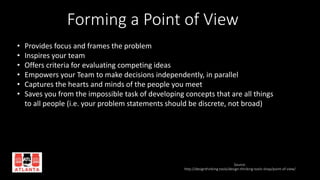Introduction to qualitative research
- 1. Introduction to Qualitative Research for Service Design Sandjar Kozubaev @sandjar
- 2. Hello my name is Sandjar! Experience Designer, Futurist PhD Student
- 5. How can we fully understand the human experience through words? (so we can design a service)
- 6. Qualitative research can get us very close
- 7. ¡ but we need to understand what we¡¯re aiming for
- 8. Dimensions of Experience Credit: Nathan Shedroff http://nathan.com/making-meaning/
- 9. Dimensions of Experience Credit: Nathan Shedroff http://nathan.com/making-meaning/ Does this fit into my world? Is this me? How does it make me feel? ¡at a price that¡¯s worth it? Does this do what I need?
- 10. 15 Meanings Credit: Nathan Shedroff http://nathan.com/making-meaning/ Accomplishment Beauty Creation Community Duty Enlightenment Freedom Harmony Justice Oneness Redemption Security Truth Validation Wonder WARNING: This is not science, this is design (interpretive, generative, rhetorical)!
- 11. Questions, Questions Based on Creswell: https://masscommtheory.com/2011/05/05/writing-good-qualitative-research-questions/ ? Begin with words such as ¡°how¡± or ¡°what¡± ? Tell the user/customer what you are attempting to ¡°discover,¡± ¡°generate,¡± ¡°explore,¡± ¡°identify,¡± or ¡°describe¡± ? Ask ¡°when was the last time?¡± to jog a memory about a specific situation ? Ask ¡°what happened?¡± to help craft your description ? Ask ¡°how does/did it make you feel?¡± to understand feelings and emotions ? Ask ¡°what happened next?¡± to explore the process over time ? Ask ¡°tell me more?¡± to thicken the description ? Ask ¡°what do you mean by that?¡± to solicit alternative explanations ? Ask ¡°why is it important to you?¡± to get to values and meanings
- 12. Forming a Point of View Source: http://designthinking.tools/design-thinking-tools-shop/point-of-view/ ? Provides focus and frames the problem ? Inspires your team ? Offers criteria for evaluating competing ideas ? Empowers your Team to make decisions independently, in parallel ? Captures the hearts and minds of the people you meet ? Saves you from the impossible task of developing concepts that are all things to all people (i.e. your problem statements should be discrete, not broad)
- 13. Forming a Point of View Source: Laddering Theory, Method, Analysis and Interpretation by Reylnods and Gutman Laddering Theory and ACV Analysis (A)ttributes (C)onsequences (V)alues ¡°These association networks, or ladders, referred to as perceptual orientations, represent combination of elements that serve as the basis of distinguishing between and among products in a given product class¡±
- 14. Forming a Point of View Source: http://dschool.stanford.edu/use-our-methods/ [USER] needs to [USER¡¯S NEED] because [UNIQUE INSIGHT] ¡°A teenage girl needs more nutritious food because vitamins are vital to good health¡±
- 15. Forming a Point of View Source: http://dschool.stanford.edu/use-our-methods/ [USER] needs to [USER¡¯S NEED] because [UNIQUE INSIGHT] ¡°A teenage girl needs more nutritious food because vitamins are vital to good health¡± VS ¡°A teenage girl with a bleak outlook needs to feel more socially accepted when eating healthy food, because in her hood a social risk is more dangerous than a health risk.¡±
- 16. Forming a Point of View Source: http://dschool.stanford.edu/use-our-methods/ [USER] needs to [USER¡¯S NEED] because [UNIQUE INSIGHT] ¡°A teenage girl needs more nutritious food because vitamins are vital to good health¡± VS ¡°A teenage girl with a bleak outlook needs to feel more socially accepted when eating healthy food, because in her hood a social risk is more dangerous than a health risk.¡±
- 17. Thank You Sandjar Kozubaev sandjar.kozubaev@sparksgrove.com Twitter: @sandjar /sankoz Source: http://dschool.stanford.edu/use-our-methods/














![Forming a Point of View
Source:
http://dschool.stanford.edu/use-our-methods/
[USER] needs to [USER¡¯S NEED] because [UNIQUE INSIGHT]
¡°A teenage girl needs more nutritious food because vitamins are vital to good
health¡±](https://image.slidesharecdn.com/introductionforqualitativeresearch-170218160132/85/Introduction-to-qualitative-research-14-320.jpg)
![Forming a Point of View
Source:
http://dschool.stanford.edu/use-our-methods/
[USER] needs to [USER¡¯S NEED] because [UNIQUE INSIGHT]
¡°A teenage girl needs more nutritious food because vitamins are vital to good
health¡±
VS
¡°A teenage girl with a bleak outlook needs to feel more socially accepted when
eating healthy food, because in her hood a social risk is more dangerous than a
health risk.¡±](https://image.slidesharecdn.com/introductionforqualitativeresearch-170218160132/85/Introduction-to-qualitative-research-15-320.jpg)
![Forming a Point of View
Source:
http://dschool.stanford.edu/use-our-methods/
[USER] needs to [USER¡¯S NEED] because [UNIQUE INSIGHT]
¡°A teenage girl needs more nutritious food because vitamins are vital to good
health¡±
VS
¡°A teenage girl with a bleak outlook needs to feel more socially accepted when
eating healthy food, because in her hood a social risk is more dangerous than a
health risk.¡±](https://image.slidesharecdn.com/introductionforqualitativeresearch-170218160132/85/Introduction-to-qualitative-research-16-320.jpg)
